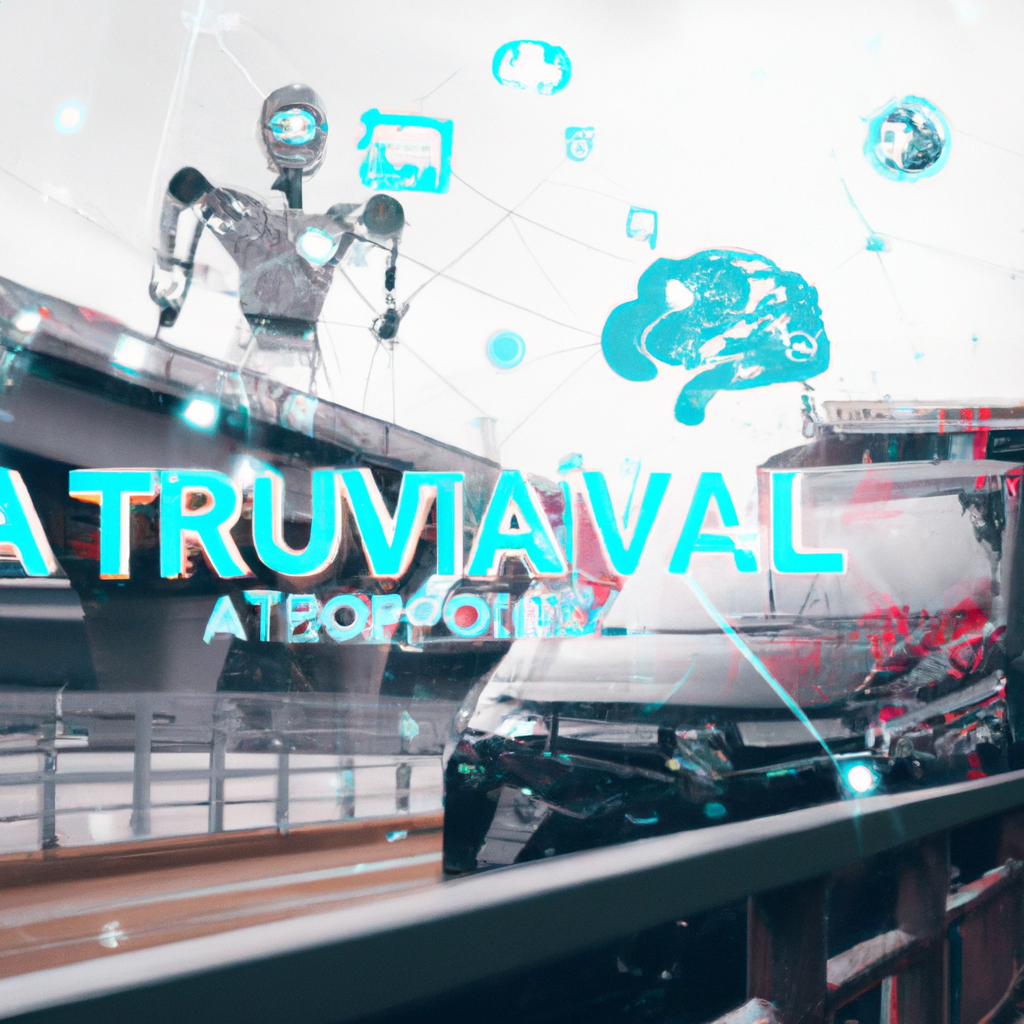-
Table of Contents
- Introduction
- How AI Tools are Revolutionizing the Transportation Industry
- Exploring the Potential of Autonomous Vehicles and AI-Driven Logistics
- The Impact of AI on the Future of Public Transportation
- The Benefits of AI-Powered Traffic Management Systems
- How AI is Transforming the Delivery and Logistics Industry
- Conclusion
“Unlock the Possibilities of Tomorrow with AI-Powered Transportation Solutions!”
Introduction
The future of Artificial Intelligence (AI) tools in transportation is an exciting and rapidly evolving field. AI has the potential to revolutionize the way we move people and goods, from autonomous vehicles to intelligent traffic management systems. AI can help reduce traffic congestion, improve safety, and increase efficiency in transportation networks. AI can also be used to optimize routes, predict demand, and provide real-time information to travelers. In this article, we will explore the potential of AI tools in transportation and discuss the challenges and opportunities that lie ahead.
How AI Tools are Revolutionizing the Transportation Industry
The transportation industry is undergoing a revolution, and it’s all thanks to the power of artificial intelligence (AI). AI tools are transforming the way we move people and goods from one place to another, making transportation faster, safer, and more efficient than ever before.
AI is being used to automate many of the processes involved in transportation, from route planning to traffic management. AI-powered algorithms can analyze vast amounts of data to identify the most efficient routes and predict traffic patterns. This helps to reduce congestion and save time, fuel, and money.
AI is also being used to improve safety in the transportation industry. AI-powered cameras and sensors can detect potential hazards on the road, such as potholes, debris, and other obstacles. This helps to reduce the risk of accidents and improve overall safety.
AI is also being used to improve customer service in the transportation industry. AI-powered chatbots can provide customers with real-time information about their journey, such as estimated arrival times and delays. This helps to reduce customer frustration and improve customer satisfaction.
Finally, AI is being used to improve the efficiency of the transportation industry. AI-powered robots can be used to automate many of the tasks involved in transportation, such as loading and unloading cargo. This helps to reduce labor costs and improve efficiency.
The transportation industry is undergoing a revolution, and AI is at the heart of it. AI tools are making transportation faster, safer, and more efficient than ever before. It’s an exciting time for the industry, and the possibilities are endless.
Exploring the Potential of Autonomous Vehicles and AI-Driven Logistics
Autonomous vehicles and AI-driven logistics are two of the most exciting and innovative technologies of our time. They have the potential to revolutionize the way we move goods and people around the world, and to make our lives easier and more efficient.
Autonomous vehicles are vehicles that can drive themselves without the need for a human driver. They use a combination of sensors, cameras, and artificial intelligence (AI) to navigate their environment and make decisions. Autonomous vehicles can be used for a variety of applications, from delivering goods to providing transportation services. They can also be used to reduce traffic congestion and improve safety on the roads.
AI-driven logistics is the use of AI to optimize the movement of goods and people. AI-driven logistics systems can analyze data from multiple sources to determine the most efficient routes and delivery times. They can also be used to predict demand and optimize inventory levels. AI-driven logistics systems can help reduce costs and improve customer service.
The potential of autonomous vehicles and AI-driven logistics is immense. They can help reduce traffic congestion, improve safety, and reduce costs. They can also help reduce emissions and improve the efficiency of transportation networks. Autonomous vehicles and AI-driven logistics can also help create new jobs and business opportunities.
The future of autonomous vehicles and AI-driven logistics is bright. As these technologies continue to develop, they will become more reliable and efficient. They will also become more affordable and accessible to more people. Autonomous vehicles and AI-driven logistics have the potential to revolutionize the way we move goods and people around the world.
The Impact of AI on the Future of Public Transportation
The future of public transportation is looking brighter than ever, thanks to the introduction of artificial intelligence (AI). AI is revolutionizing the way we travel, making it easier, faster, and more efficient. From self-driving cars to automated ticketing systems, AI is transforming the way we get around.
AI is already being used in public transportation systems around the world. Self-driving cars are being tested in cities like London and Tokyo, and automated ticketing systems are being used in cities like New York and San Francisco. AI is also being used to monitor traffic patterns and optimize routes, making it easier for commuters to get where they need to go.
The potential of AI in public transportation is immense. AI can be used to reduce traffic congestion, improve safety, and reduce the cost of transportation. AI can also be used to provide real-time information about routes and schedules, making it easier for commuters to plan their trips.
AI can also be used to improve the customer experience. AI-powered chatbots can provide personalized customer service, and AI-powered facial recognition systems can be used to streamline ticketing and boarding processes.
The future of public transportation is bright, and AI is playing a major role in making it happen. AI is making it easier, faster, and more efficient to get around, and it’s only going to get better. With AI, the future of public transportation looks brighter than ever.
The Benefits of AI-Powered Traffic Management Systems
Traffic management systems powered by artificial intelligence (AI) are becoming increasingly popular as cities and towns look for ways to reduce congestion and improve safety on their roads. AI-powered traffic management systems offer a number of benefits that can help make roads safer and more efficient.
First, AI-powered traffic management systems can help reduce congestion. By using AI to analyze traffic patterns, these systems can identify areas of congestion and suggest ways to reduce it. For example, they can suggest alternate routes or suggest changes to traffic signals to help reduce the number of cars on the road. This can help reduce the amount of time drivers spend stuck in traffic, making their commutes more efficient.
Second, AI-powered traffic management systems can help improve safety. By analyzing traffic patterns, these systems can identify areas where accidents are more likely to occur and suggest ways to reduce the risk. For example, they can suggest changes to traffic signals or suggest alternate routes to help reduce the number of cars on the road in high-risk areas. This can help reduce the number of accidents on the road, making it safer for everyone.
Finally, AI-powered traffic management systems can help reduce emissions. By analyzing traffic patterns, these systems can identify areas where emissions are higher and suggest ways to reduce them. For example, they can suggest changes to traffic signals or suggest alternate routes to help reduce the number of cars on the road in high-emission areas. This can help reduce the amount of air pollution in cities, making them healthier places to live.
Overall, AI-powered traffic management systems offer a number of benefits that can help make roads safer and more efficient. By reducing congestion, improving safety, and reducing emissions, these systems can help make cities and towns better places to live.
How AI is Transforming the Delivery and Logistics Industry
The delivery and logistics industry is undergoing a major transformation thanks to the introduction of artificial intelligence (AI). AI is revolutionizing the way businesses manage their supply chains, optimize delivery routes, and track shipments.
AI-powered solutions are helping businesses to automate mundane tasks, such as order processing and inventory management. This allows them to focus on more important tasks, such as customer service and product development. AI can also be used to analyze customer data and predict customer needs, allowing businesses to provide better service and more personalized experiences.
AI is also being used to optimize delivery routes. By analyzing customer data, AI can determine the most efficient routes for delivery drivers. This helps businesses save time and money, while also reducing their environmental impact.
AI is also being used to track shipments. By using sensors and GPS tracking, businesses can monitor the location of their shipments in real-time. This helps them to ensure that shipments arrive on time and in good condition.
Finally, AI is being used to improve customer service. AI-powered chatbots can provide customers with quick and accurate answers to their questions. This helps businesses to provide better customer service and reduce customer wait times.
Overall, AI is transforming the delivery and logistics industry in a number of ways. By automating mundane tasks, optimizing delivery routes, tracking shipments, and improving customer service, AI is helping businesses to become more efficient and provide better service to their customers.
Conclusion
The Future of AI Tools in Transportation is very promising. AI tools are already being used in many areas of transportation, from autonomous vehicles to traffic management systems. As AI technology continues to develop, it will become even more integrated into transportation systems, allowing for more efficient and safer transportation. AI tools will also help to reduce traffic congestion, improve safety, and reduce emissions. In the future, AI tools will be used to create smarter, more efficient transportation systems that will benefit everyone.





